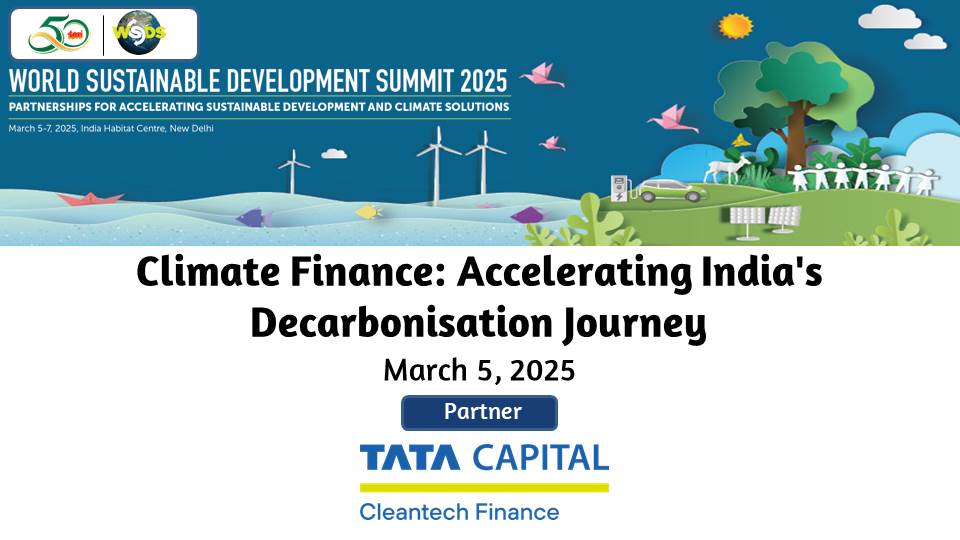WSDS 2025 Thematic Tracks - Climate Finance: Accelerating India's Decarbonisation Journey

India is undergoing a significant energy transition, marked by an increasing reliance on renewable energy sources. As of October 2024, the country’s renewable energy-based electricity generation capacity stands at 203.18 GW, accounting for 46.3% of its total installed capacity of 452.69 GW. This progress underscores India's commitment to cleaner, non-fossil fuel energy sources and its broader climate action goals. These efforts align with India’s enhanced Nationally Determined Contributions under the Paris Agreement, which include reducing emissions intensity by 45% by 2030, sourcing 50% of cumulative electric power capacity from non-fossil fuels by the same year, and achieving net-zero emissions by 2070. This path to net-zero is intertwined with economic growth, with India's population projected to grow by a quarter billion and its GDP expected to expand from USD 3 trillion in 2023 to USD 27 trillion by mid-century.
Energy demand will rise significantly as the economy grows, necessitating ambitious interim targets for 2030. These include 500 GW of non-fossil-fuel capacity, meeting 50% of energy needs from renewable sources, reducing carbon emissions by 1 billion tonnes, and cutting carbon intensity by 45%. Achieving these goals requires substantial financial investment. India’s original NDC estimated a need of USD 2.5 trillion from 2015 to 2030, equivalent to USD 170 billion annually. Cumulative investments to achieve net-zero emissions by 2070 are projected at USD 10.1 trillion, highlighting the need for large-scale financing to scale renewable energy installations, modernize infrastructure, and enhance energy efficiency.
India has made strides in attracting green finance by leveraging sector-specific financial institutions and accessing global markets. However, traditional financing sources face challenges such as regulatory uncertainties, lengthy project gestation periods, and misaligned investor expectations. Low-carbon projects in emerging economies like India are often perceived as high-risk, which deters large-scale commitments despite the growing pool of global green capital. Overcoming these barriers requires fostering a sustainable finance ecosystem through policy reforms and innovative financial mechanisms. Green bonds, blended finance models, and public-private partnerships can de-risk investments and align them with India’s energy transition goals. Attracting global institutional investors, sovereign wealth funds, and infrastructure funds necessitates an enabling environment that demonstrates measurable returns and mitigates perceived risks.
India can also diversify funding sources by engaging the private sector and leveraging multilateral development banks and international climate funds. Strengthening regulatory frameworks, ensuring policy stability, and enhancing transparency are critical to building investor confidence. Domestic financial institutions must play a pivotal role in channeling green finance while technological innovation and capacity building drive cost efficiency and scalability. From a regulatory standpoint, the Indian government has introduced or streamlined various financial regulations to attract capital for green projects, including automatic approval for FDI, strengthening Power Purchase Agreements, establishing renewable energy parks and green corridors, and streamlining the bidding processes.
India stands at a transformative juncture in its energy landscape. Realizing its vision for a low-carbon future requires collaborative efforts among policymakers, private players, and institutional investors. By leveraging global green capital and fostering a conducive policy environment, India can bridge its climate finance gap and accelerate its transition to a decarbonised economy.
This thematic track will deliberate the role of private players and institutional investors, key reforms, and mechanisms needed to align policy discourse with India’s long-term energy transition goals.
Policy Recommendations/ Outcomes
Scale Up Climate Finance Through Policy Reforms and Financial Innovation: Achieving India’s decarbonisation targets requires massive investments—approximately USD 2.5 trillion by 2030 and over USD 10 trillion by 2070. Participants stressed the need for policy reforms, innovative financial instruments, and stronger public-private partnerships to unlock and accelerate green finance flows.
Leverage Digitisation and Smart Technology for Energy Efficiency: The event underscored the growing role of digital transformation and smart technologies—including smart meters and IT-enabled infrastructure—in improving efficiency, monitoring, and electricity management. These tools are critical for ensuring that electricity is not merely treated as a commodity but delivered as a reliable service, supporting the larger energy transition.
